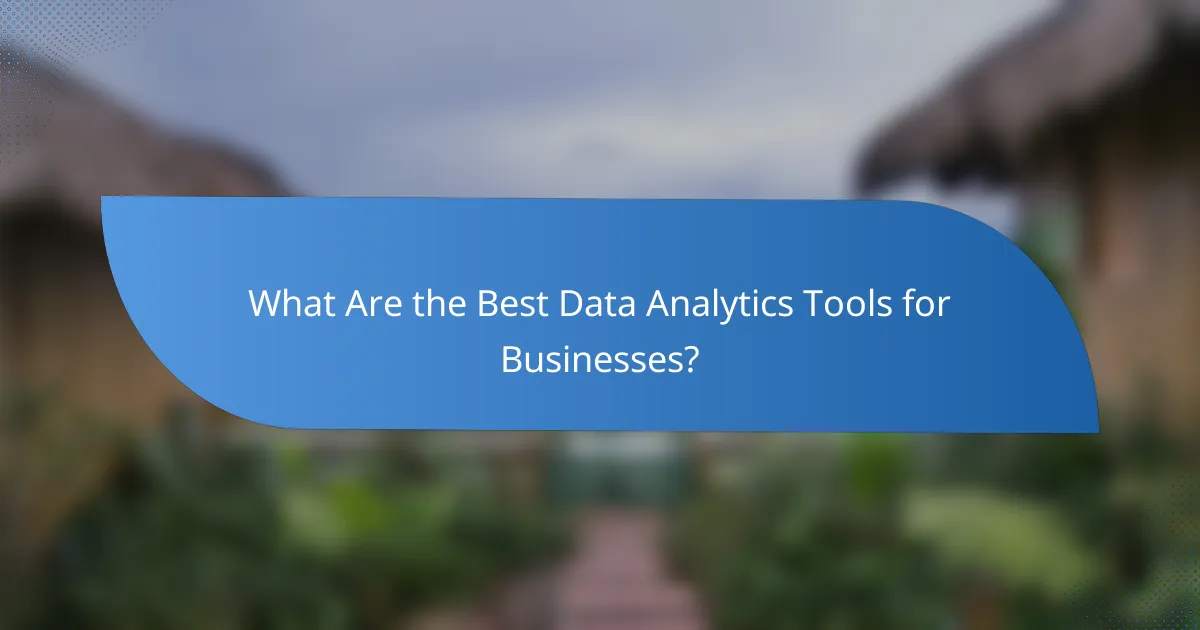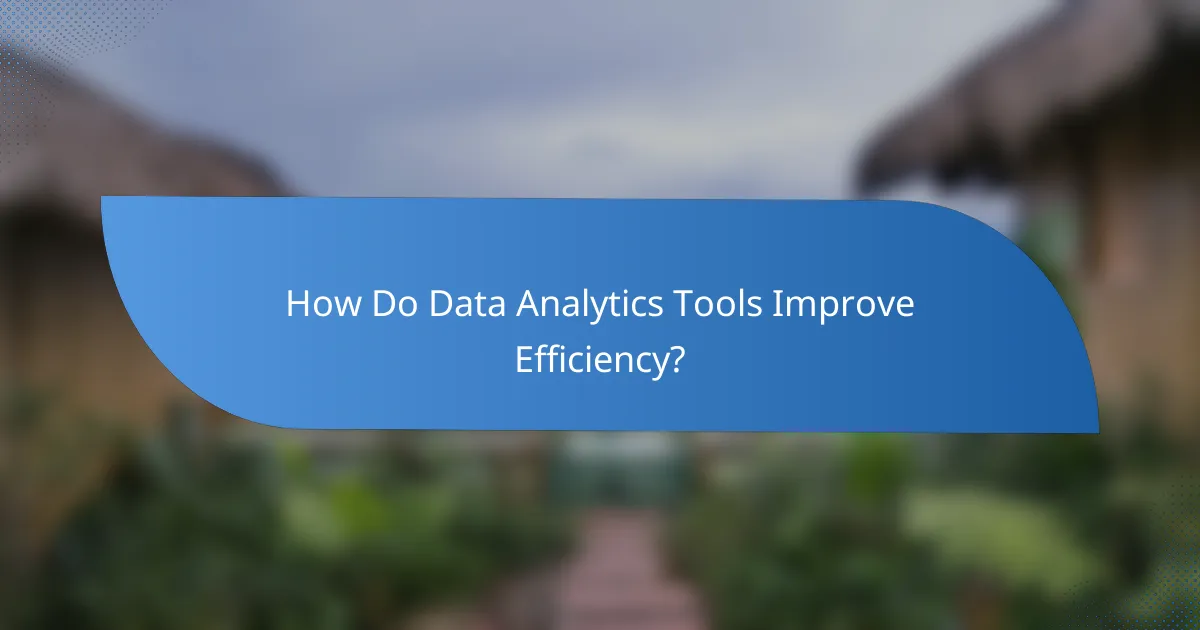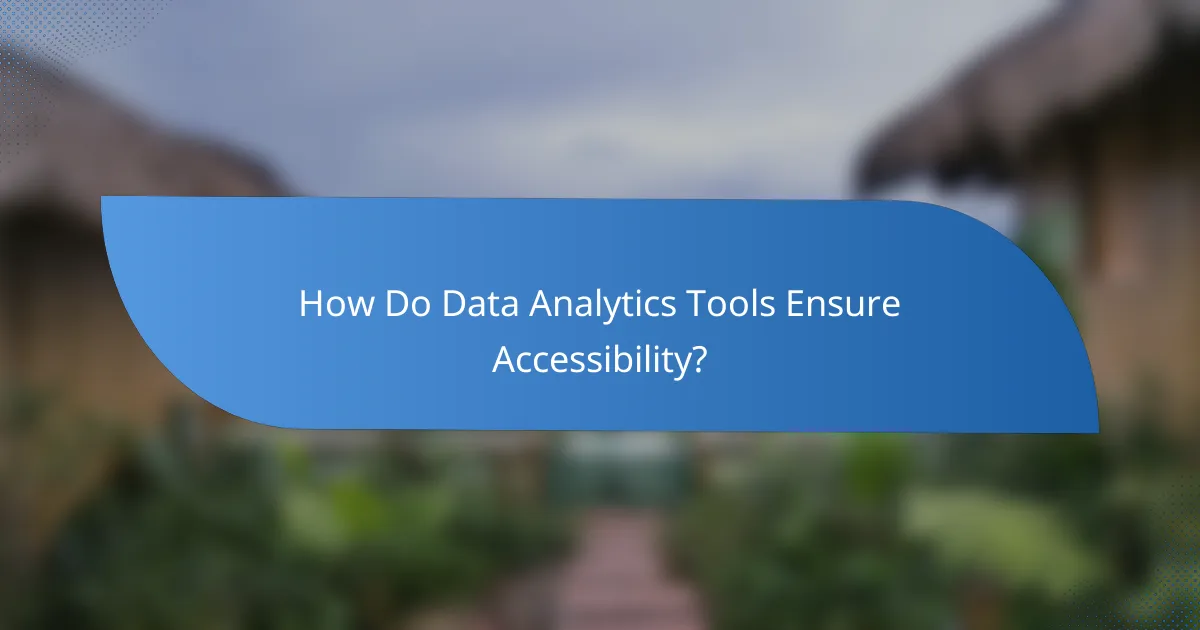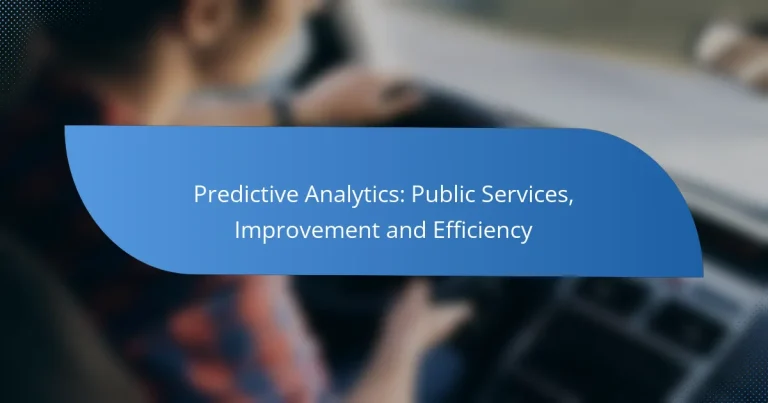Data Analytics Tools: Efficiency, Accessibility and Integration
Data analytics tools play a crucial role in helping businesses analyze information efficiently and make informed decisions. By automating processes and integrating various data sources, these tools enhance accessibility and streamline workflows. With options like Tableau, Power BI, and Google Analytics, organizations can customize their data views and focus on strategic initiatives rather than manual data management.

What Are the Best Data Analytics Tools for Businesses?
The best data analytics tools for businesses include Tableau, Power BI, Google Analytics, Looker, and Qlik Sense. These tools help organizations analyze data efficiently, improve accessibility, and integrate various data sources for better decision-making.
Tableau
Tableau is a leading data visualization tool that enables users to create interactive and shareable dashboards. It connects to various data sources, allowing businesses to visualize trends and insights quickly.
Consider Tableau for its user-friendly interface and robust community support. It is particularly effective for organizations needing to present data visually to stakeholders.
Power BI
Power BI, developed by Microsoft, is a powerful analytics tool that integrates seamlessly with other Microsoft products. It offers a range of data connectors and visualization options, making it suitable for businesses already using Microsoft services.
With Power BI, organizations can create real-time dashboards and reports. Its pricing model is competitive, often appealing to small and medium-sized enterprises looking for cost-effective solutions.
Google Analytics
Google Analytics is a widely-used web analytics service that tracks and reports website traffic. It provides insights into user behavior, helping businesses optimize their online presence and marketing strategies.
Utilize Google Analytics for its free tier, which is suitable for small businesses. However, larger enterprises may benefit from the premium version, which offers advanced features and increased data limits.
Looker
Looker is a modern data platform that focuses on business intelligence and data exploration. It allows users to create custom reports and dashboards tailored to specific business needs.
Looker is particularly beneficial for organizations that require in-depth data analysis and collaboration across teams. Its integration capabilities with various data sources enhance its usability for data-driven decision-making.
Qlik Sense
Qlik Sense is a self-service data analytics tool that empowers users to create personalized reports and dashboards. Its associative model allows for flexible data exploration, making it easy to uncover insights.
Consider Qlik Sense for its strong data integration capabilities and user-friendly interface. It is ideal for businesses that prioritize data discovery and need to analyze large datasets efficiently.

How Do Data Analytics Tools Improve Efficiency?
Data analytics tools enhance efficiency by automating processes, enabling faster insights, and streamlining decision-making. These tools reduce manual effort and time spent on data management, allowing teams to focus on strategic tasks.
Automated Reporting
Automated reporting simplifies the generation of regular reports by pulling data from various sources and presenting it in a user-friendly format. This reduces the time analysts spend compiling data, enabling them to deliver insights more quickly.
For example, businesses can set up weekly sales reports that automatically update with the latest figures, eliminating the need for manual data entry. This not only saves time but also minimizes errors in reporting.
Real-time Data Processing
Real-time data processing allows organizations to analyze data as it is generated, providing immediate insights. This capability is crucial for industries like finance and e-commerce, where timely decisions can significantly impact outcomes.
For instance, a retail company can track customer behavior on its website in real-time, adjusting marketing strategies instantly based on user interactions. This responsiveness can lead to increased sales and improved customer satisfaction.
Enhanced Decision Making
Data analytics tools support enhanced decision-making by providing actionable insights derived from comprehensive data analysis. By leveraging historical and current data, organizations can identify trends and make informed choices that align with their goals.
Companies should focus on integrating analytics into their decision-making processes, ensuring that stakeholders have access to relevant data. This can involve training staff on how to interpret analytics reports effectively, fostering a data-driven culture within the organization.

What Are the Key Features of Effective Data Analytics Tools?
Effective data analytics tools possess features that enhance user experience, facilitate integration with other systems, and allow for customizable views of data. These attributes are essential for businesses looking to derive actionable insights efficiently and effectively.
User-friendly Interface
A user-friendly interface is crucial for ensuring that users can navigate the tool with ease. Intuitive design minimizes the learning curve, allowing users to focus on data analysis rather than struggling with complex functionalities. Look for tools that offer clear navigation, simple menus, and helpful tutorials.
For example, platforms like Tableau and Microsoft Power BI are known for their straightforward interfaces, making it easier for users to create visualizations without extensive training. Prioritize tools that provide drag-and-drop features and customizable layouts to enhance usability.
Integration Capabilities
Integration capabilities determine how well a data analytics tool can connect with other software and data sources. Effective tools should seamlessly integrate with databases, cloud services, and third-party applications to streamline data flow. This connectivity is vital for maintaining up-to-date information and ensuring comprehensive analysis.
Consider tools that support APIs and have pre-built connectors for popular platforms like Salesforce, Google Analytics, and various ERP systems. This will save time and reduce manual data entry, allowing for real-time insights and improved decision-making.
Customizable Dashboards
Customizable dashboards allow users to tailor their data visualization to meet specific needs and preferences. This feature enables users to display relevant metrics and KPIs in a way that makes sense for their unique business context. A well-designed dashboard can significantly enhance data comprehension and facilitate quicker insights.
Look for tools that offer drag-and-drop widgets, various chart types, and the ability to filter data dynamically. This flexibility ensures that users can adapt their dashboards as business priorities change, providing ongoing relevance and utility.

How Do Data Analytics Tools Ensure Accessibility?
Data analytics tools enhance accessibility by providing user-friendly interfaces, cloud-based access, and mobile compatibility. These features allow a wider range of users to engage with data insights, regardless of their technical expertise or location.
Cloud-based Solutions
Cloud-based data analytics tools enable users to access data from anywhere with an internet connection. This flexibility eliminates the need for expensive hardware and allows for real-time collaboration among teams, which is essential for timely decision-making.
Examples of popular cloud-based analytics platforms include Google Analytics and Microsoft Power BI. These tools often offer tiered pricing plans, making them accessible for small businesses and large enterprises alike.
Mobile Compatibility
Mobile compatibility ensures that users can access data analytics tools on smartphones and tablets, enhancing convenience. This feature is crucial for professionals who need to make decisions on the go, as it allows for quick insights without being tethered to a desktop.
Many analytics platforms offer dedicated mobile apps or responsive web designs. Users should look for tools that provide a seamless experience across devices to maximize accessibility.
Role-based Access Control
Role-based access control (RBAC) allows organizations to manage who can view or manipulate data based on their roles. This feature enhances security and ensures that sensitive information is only accessible to authorized personnel, which is vital for compliance with regulations like GDPR.
Implementing RBAC can streamline workflows by giving team members access to the specific data they need. Organizations should regularly review access permissions to maintain security and adapt to changing team structures.

What Are the Integration Options for Data Analytics Tools?
Data analytics tools offer various integration options that enhance their functionality and usability. These options allow users to connect with other software, streamline workflows, and improve data accessibility.
API Integrations
API integrations enable data analytics tools to communicate with other applications and services seamlessly. By using APIs, users can automate data transfers, access real-time information, and enhance reporting capabilities. For instance, integrating a data analytics tool with a customer relationship management (CRM) system can provide insights into customer behavior without manual data entry.
When considering API integrations, evaluate the documentation and support provided by the analytics tool. A well-documented API can significantly reduce implementation time and troubleshooting efforts. Additionally, ensure that the APIs are secure and comply with relevant data protection regulations.
Third-party Software Compatibility
Third-party software compatibility refers to the ability of data analytics tools to work with external applications, such as databases, visualization tools, and business intelligence platforms. This compatibility is crucial for organizations that rely on multiple software solutions to manage their data.
To maximize compatibility, look for analytics tools that support popular file formats and data sources, such as CSV, Excel, SQL databases, and cloud storage services. Additionally, consider tools that offer built-in connectors for widely used platforms like Google Analytics, Salesforce, or Tableau, as these can simplify integration processes and enhance overall efficiency.






